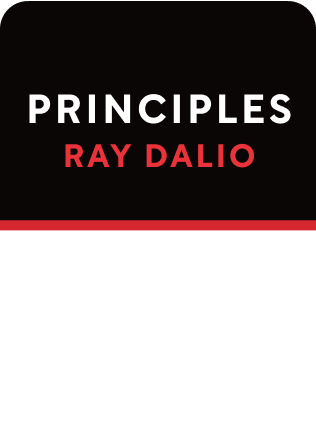

This article is an excerpt from the Shortform summary of "Principles: Life and Work" by Ray Dalio. Shortform has the world's best summaries of books you should be reading.
Like this article? Sign up for a free trial here .
What are Ray Dalio’s principles for life? How can you use the principles for life, and what are they for?
The principles for life are part of a five-step process that will allow you to get anything you want out of life. The principles for life allow you to set goals, and pursue them with creativity and discipline.
Read to find out more about the principles for life.
Basic Principles for Life
There is a 5-step process for getting anything that you want out of life. These are the guiding principles in life. It goes:
- Set clear goals.
- Identify problems and don’t tolerate them.
- Diagnose your problems to find root causes.
- Design solutions to get around problems.
- Do the tasks required to completion.
To achieve success, you need to follow each of these steps in order, one at a time. When setting goals, you shouldn’t think about barriers—just set the goals. When diagnosing your problems, don’t worry about how you’ll solve them—just find the root causes. Establishing basic principles of life can help.
These 5 steps also form a loop. Once you complete one turn of the loop, then you’ll look at your results and go through the process again, setting new, higher goals.
Learning the guiding principles in life is simple. But simple doesn’t mean easy. This sounds like common sense, but executing it day in and day out is the hard part.
We’ll break down each of the steps further in the principles for life.
1. Set Clear Goals
To know where you’re aiming, you need to set clear goals. Here are pointers on how to do this.
Be audacious. If you think something’s unattainable, that’s only because your current knowledge is limited. Once you start trying to achieve your lofty goals, you’ll learn a lot. Paths will emerge that were inconceivable to you before once you start paying attention to the guiding principles in life.
- On the contrary, if you know you can achieve your goal, you’re not aiming high enough.
- Remember, follow the 5 steps in order. Set your goals first without worrying about the obstacles you’ll run into.
Each of us has goals and desires. Goals are what we want rationally, while our desires are what we want on a passionate or emotional level. (Shortform note: At times, the two conflict—losing weight is difficult for lots of people because our goal is to be in perfect health, but we also desire food.) But when your goals align with your desires, it becomes easier to achieve your goals.
Choosing what NOT to do is often as important as choosing what to do.
- You can have just about anything you want, but not everything you want. People are often afraid to close down options for themselves, and as a consequence they chase too many goals at once. This spreads their attention then, and they achieve few of their many goals.
- Instead, reject good alternatives to pursue even better ones.
Don’t confuse goals with tasks. The goal is the outcome you ultimately want to achieve. The task is merely what you need to do to get there, and the principles for life can help.
If money comes up naturally as a top goal for you, be wary of setting money as a primary goal.
- To Dalio, meaningful work and relationships make you much happier than money does. There are only so many things that money can buy, and great relationships are not one of them.
- Start with your real non-money goals, then work your way backwards into the money you need.
- Dalio argues having the basics—a good bed, good relationships, good food, good sex—is most important and don’t get much better when you have more money.
These are some of the guiding principles in life.
2. Identify Problems and Don’t Tolerate Them
Overcoming Your Ego
Problems are painful. Your ego and your desire for comfort get in the way of recognizing problems. Many people are afraid to highlight their weaknesses, and thinking about problems makes them anxious. You won’t be able to address basic principles of life without overcoming your ego.
To overcome this hesitation, realize what happens if you don’t recognize problems—you’ll set yourself much further back from your goals. While thinking about problems may worry you, not thinking about problems should make you even more worried. You can learn basic life principles to help.
Weaknesses don’t matter if you find solutions for them.
If you want to accomplish great things, you need to push yourself to your limits. If you push yourself to your limits, you will fail a lot. These failures hurt, but the important thing is acknowledging your weaknesses and finding some way to fix them or compensate for them. Unsuccessful people don’t do this, and don’t evaluate their basic life principles.
You need to recognize problems for what they are—opportunities for improvement.
- View life as a game that throws challenges at you that you must struggle with and overcome.
- Acknowledging your problems is not the same as surrendering to them. You will find ways to get around problems.
Think of yourself as a machine, feeding in resources and information, and producing outcomes. Viewing yourself top-down like this helps with objectivity.
- Imagine your air conditioner is broken. Would you tolerate that? Or would you try to find the problems? If you wouldn’t tolerate a broken air conditioner, why should you treat yourself differently?
People who succeed look at themselves unflinchingly. They understand their weaknesses objectively, rather than shying away from them, and understand the basic principles of life.
Finding Problems
Be specific about what the problem is. The more precise you can be about what the problem is, the better the solution you can design.
- Start from the symptom instead of poking at root causes. “I can’t get enough sleep” is not a problem. The symptom is “I’m performing poorly at work.”
Be clear about what problems are big and what problems are small. Invest your energy in problems that will get you the biggest returns, just like how you would invest your money. But also make sure small problems aren’t symptoms of big problems.
Hold yourself accountable for problems. Every failure is your personal failure—this means you weren’t creative or flexible or determined enough to do what it takes. You need to get better to find the way to succeed.
Once you identify your problems, have zero tolerance for your problems. If you don’t care enough to solve your problems, or if you don’t have the will to solve it, then your situation is hopeless.
3. Diagnose Problems to Find Root Causes
Root causes are the most fundamental cause of the problem. Often, there can be a chain reaction of problems. Your immediate (or proximate) problem might be that you feel tired at work because you don’t sleep long enough. But the root cause is deeper than this—you might not sleep long enough because you lack discipline in keeping your sleep time and get distracted by your phone.
Using a medical analogy, your problems are symptoms, and the root cause is the disease. To stop your symptoms, you need to cure the disease. Likewise, to be able to truly solve your problems, you must identify the root cause.
Again, take this step in order, by itself, without worrying about other steps. Focus on what the problem is and what caused it, before worrying about how to solve it.
Tips on Diagnosing Problems
There are a few questions to ask yourself to get at root causes.
- Why didn’t things go as they should have?
- Ask Why? five times to get at root causes. This will get you to deeper layers of understanding.
- Is the root cause a pattern?
Rely on other people to look at yourself objectively.
- Speak with credible people and look at the evidence together.
- Get other people comfortable with pointing out your mistakes. Make clear they’re not going to hurt you.
Often your problems have to do with bad personal habits. These are important. If you can rid yourself of your top three harmful habits, you will radically improve the trajectory of your life.
Take time to diagnose problems. Definitely take more than 15 minutes. Sometimes it can take hours (but most people don’t spend hours really diving into their problems).
(Shortform note: There are more tactics on this step in the Work Principles section on the 5-steps.)
4. Design Solutions to Get Around Problems
Before you jump to solving problems, look backwards in time. Replay the story of what you have done to get you in your current position, and what basic life principles you’ve had so far.
Then look down on yourself objectively, like a machine, and find changes to produce better outcomes.
- Say you have a problem with distraction and you check your phone every 10 seconds. Now think of a machine that has the same problem. Would you tolerate a microwave that shuts off every 10 seconds to check its phone? If not, why would you tolerate this in yourself?
Next, visualize what you need to do to get around the problems. Literally visualize it—think of what must happen at what times to reach your goals.
- Think of your plan as a movie script, with people playing roles at specific times.
To build out your plan, drill down from high level to specific tasks and timelines. Start from high level and drill down into low-level details.
Write down your plan for everyone to see and measure your progress against.
5. Do the Tasks Required to Completion
Once you have your plan, you need to execute it. You need the discipline to act out your script.
Have good work habits. Prioritize your to-do lists, and tick them off in order.
Measure your progress by setting clear, well-defined metrics. If you aren’t meeting your metrics, that’s a problem that needs to be diagnosed and solved.
To keep up your motivation, remember the goals you want to achieve, and how your plans will help you achieve those goals. If you lose sight of this “why?” you will lose sight of your goals, and you will lose motivation in your plan.
Those are all five steps. It sounds simple. But simple doesn’t mean easy.

———End of Preview———
Like what you just read? Read the rest of the world's best summary of Ray Dalio's "Principles: Life and Work" at Shortform .
Here's what you'll find in our full Principles: Life and Work summary :
- How Ray Dalio lost it all on bad bets, then rebounded to build the world's largest hedge fund
- The 5-step process to getting anything you want out of life
- Why getting the best results means being relentlessly honest with everyone you work with






